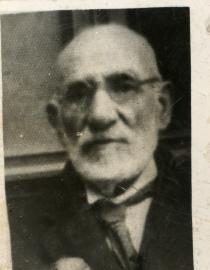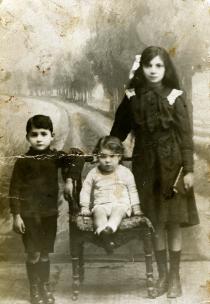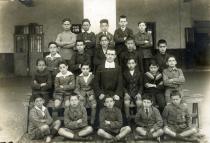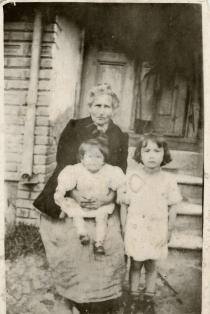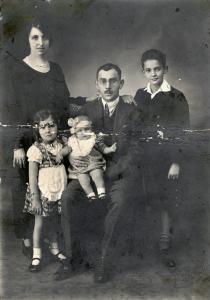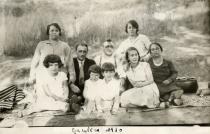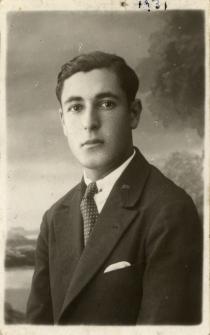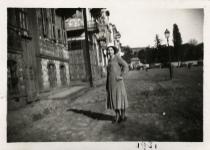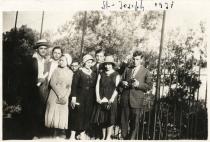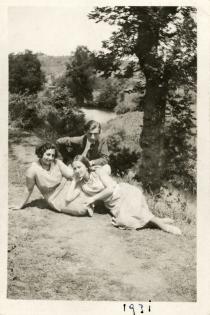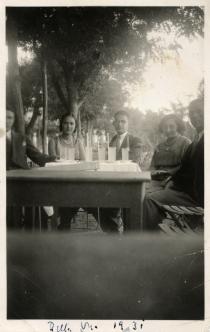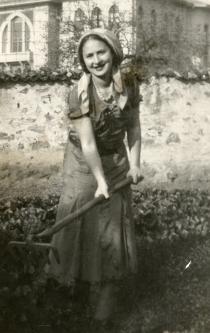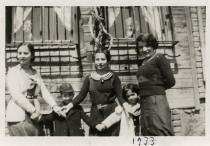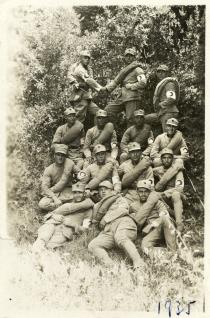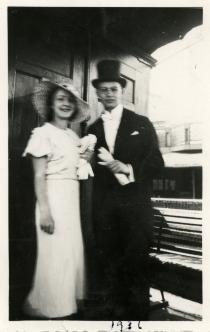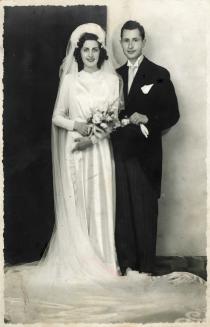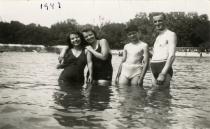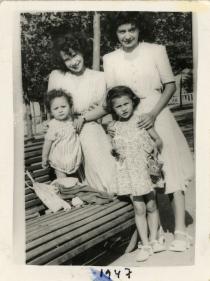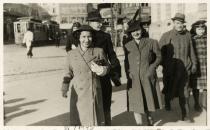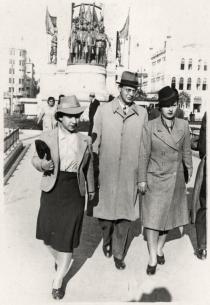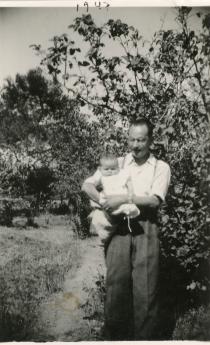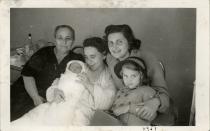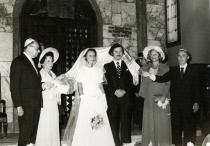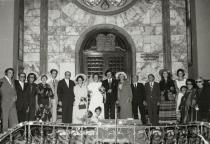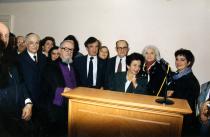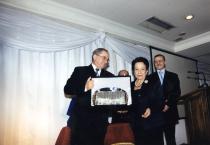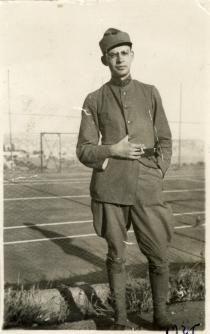
Eli (Eliyau) Perahya
Istanbul
Turkey
Interviewer: Naim Guleryuz
Date of interview: December 2004
Very well-known in the Jewish community in Istanbul, Eli Perahya’s life has been connected with cultural and social work. Besides his professional occupation he devoted 26 years of his life to the service of the Chief Rabbinate of Turkey as a financial counselor. He is regarded with love and respect by every person who knows him. His friends have unforgettable and pleasurable memories of social gatherings in his home. Eli Perahya is 92 years old now, and retired from financial counseling. He lives with his equally beloved and respected wife Klara in Nisantas, an outstanding and distinguished residential district of Istanbul, in an apartment well decorated with many paintings, and a grand piano always open for someone to perform. In spite of his age he has not stopped his habit of extensive reading, researching and writing for the Shalom newspaper every week, the only Jewish newspaper of the Turkish Jewish community today. Together with his wife, he is also the co-author of a Ladino-French dictionary.
The Encyclopedia Judaica dates back the roots of the Perahya(h) family to 13th century Egypt. M. Molho, in his monograph about the Perahya family [‘Essai d’une Monographie sur la Famille Perahia’, Thessaloniki, 1938, pp. 27-33], states that the Perahya family was Salonican and that they had raised many grand rabbis. Molho also talks with awe about the very famous Perahya Library. The word Perahyah can be understood as the merge of the [Hebrew] words ‘Perah’ meaning ‘flower’ and ‘Yah’ meaning ‘God,’ so the ‘flower of God.’ Pirke Avot [‘Ethics of the Fathers’, a part of the Mishna] mentions Yeshua ben Perahya. Perahya has been mentioned also as the uncle of Isaah in Israel Zangwill’s 1 book ‘Fantaisies Italiennes’ [translated by Mme. Marcel Girette, Collection Anglia, Editions G. Cres et Cie., 1924].
I was told that my paternal grandfather, Ishak Perahya, was born in Kuzguncuk [district on the Asian side of Istanbul], and so were his brother Vitali, who married Esterina and had two sons named Jak and Salvador, and his sister Rachel, who married someone from the Keribar family, whose name I don’t remember, and didn’t have any children. Later they moved to the Haydarpasha area [district on the Asian side of Istanbul]. Unfortunately I don’t have any details about his parents or his education.
Having a thin moustache and no beard, my paternal grandfather used to wear normal urban clothes with a fez 2, and in winter he wrapped himself in his kurdi 3. He had an authoritarian but loving character; however, he never revealed his feelings much. My grandmother always addressed him as ‘siz’ [in a formal and respectful way, analogue to the French ‘Vous’ or the German ‘Sie’] and always used a third person singular question form as in: ‘A ke oras va vinir?’ [Ladino question in the formal and polite form, meaning ‘at what time will you come?’] .
My grandfather Ishak was devoted to his religion; very respectful of Shabat [Sabbath], obeyed the kasherut [kashrut] rules, and performed all his religious duties and obligations. It cannot be said that he was pious, since in those days this was the normal, standard way of life.
My paternal grandmother, Yohevet, was from the family of Fratelli Haim, who owned the famous printing house. [Editor’s note: later named ‘Kagitcilik Matbaacilik Anonim Sirketi,’ it was a modern printing house founded by the Haim brothers around the end of the 19th century, publishing books in different languages, including the review ‘Hamenora,’ edited by the Bnai Brith Association]. I don’t know anything about her parents, her childhood or education.
My maternal grandfather, Moshe Rottenberg, an Ashkenazi, emigrated from Russia, probably to flee the oppression against Jews in that country. [Editor’s note: In the late 19th century many Jews from the Russian Empire (often from Bessarabia or Southern Ukraine) as well as from Romania fled south of the Danube, to Bulgaria and the Ottoman Empire, to escape pogroms and oppression in general.] I have no idea about his birth date or birth place, but I guess he had some sisters who remained in Russia. He married here, in Istanbul, Belina Scherler, who was born in Istanbul and attended the German High School. He was the Turkish business representative of different European manufacturers. Later Moshe and Belina Rottenberg immigrated to Belgium and both died there.
I remember my paternal grandparents much better than my maternal ones, mostly because my father lived for a long time in his father’s house, even after he got married, as it was customary in those days. My maternal grandfather had lesser financial means than my paternal one, but he was more outgoing. Unfortunately I don’t have many memories of him.
My father, Yaakov Perahya, was born in Haydarpasha, Istanbul. I never knew his birth date. He attended the communal elementary school and continued his studies in the German High School of the Hilfsverein [der Deutschen Juden] 4. Together with his brother Yasef, who married Regine and had three children – Rifat, Victor and Elvira – he was a partner in their father’s millinery shop in Corapci Han [Turkish words meaning sock-maker/seller building] in Mahmutpasha [a business neighborhood in Istanbul].
My father was the only subscriber [probably not literally the only subscriber, but there must have been very few of them] in Turkey of Forverts 5, a periodical printed in Yiddish in the U.S.; the periodical came rolled up in a tube. He of course knew Yiddish very well because he had studied at the Hilfsverein Jewish school even though he himself was Sephardic. He liked to read it aloud while simultaneously translating it into French. He kept all the issues. At one time there were so many periodicals piled up at home that I remember quite clearly, my mother telling him, ‘Ya basta, los echaremos’ [Ladino: ‘enough, let’s throw them away’]. Since he was neither very talented in trading nor really interested in it, he wouldn’t go to the shop very often; mostly it was his brother and father who ran the business. Instead he preferred to go to the synagogue and the yeshiva [yeshivah] and have religious discussions with the rabbis and his friends. I probably got my habit of reading and discussing from him and later developed it further with personal effort.
Besides being Sephardic, maybe because of the German cultural background he had gotten, he was also very interested in the Ashkenazi synagogue, even to the point that he read his morning Tefila [prayer] at home one morning in the Sephardic way, another morning in the Ashkenazi way. He attended both synagogues. Because of this intimate interest of his I make a donation and add his name on the list of the deceased members of the synagogue, to be read at every Yom Kippur at 12 o’clock midday. [Editor’s note: According to the Istanbul Ashkenazi tradition, a Kaddish for the souls of the dead is recited at noon at every Yom Kippur. The names of the deceased for whom the Kaddish is to be recited are recorded beforehand. Again according to the Ashkenazi tradition, those members of the congregation whose parents are alive do not attend this prayer. They have to leave while this prayer is being read. According to the Ashkenazi tradition those whose parents are both alive are not even allowed to go to the cemeteries.]
On the other hand, I do recall my father acting as a reporter for some foreign journals and newspapers, and having a Zionist point of view. In fact when Nahum Sokolov 6, the Hebrew writer, a pioneer in modern Hebrew journalism and president of the World Zionist Organization and the Jewish Agency, visited Istanbul, the interview he made with him in Pera Palas Hotel was published in a foreign newspaper, I don’t remember which, but probably one in German. [Editor’s note: Designed by the French architect Alexander Vallaury and opened in October 1891, the Pera Palas Hotel was built primarily for use of passengers coming from Paris to Istanbul.] My father used the signature Yifrah as a pseudonym when he wrote in local Jewish weekly newspapers like El Tiempo 7 and La Vera Luz 8. I still sign some of my writings in my column, named La Huente [fountain/source], on the Judeo-Spanish page of the Shalom 9 newspaper with Ben Yifrah [Hebrew for Son of Yifrah].
My father and I didn’t have problems in our relationship. There was not the tell-tale ‘generation gap’ between us. In fact our relationship had nothing worth mentioning.
My mother, Klara Rottenberg, was born in Istanbul in 1886 as one of eight children of an Ashkenazi family. My mother’s sisters Rachel and Hanna died very young, of tuberculosis, in Istanbul. Her brothers Manuel and Josef immigrated to France whereas Leon and Cecile went to Belgium. During World War II, Manuel participated actively in the French Resistance, at Romans near Grenoble in France. When my mother died in 1988, she was 102 years old.
Although my mother’s native tongue was Yiddish, after she got married, in time she managed to communicate in Judeo-Spanish much better and more comprehensively than many Sephardi people.
My mother was a classical housewife. Although my father had a rich library at home, I don’t recall my mother making any use of it. My paternal grandmother, Yohevet, except for religious holidays, went to play cards with friends almost every afternoon and sometimes also took her daughter-in-law, my mother, with her.
According to the Muslim [Islamic] Calendar 10 my year of birth is 1328, meaning 1913 in the Gregorian calendar. I was born on 14th February in a distinguished little district of Istanbul on the Anatolian side, called Haydarpasha.
My siblings are Luisa, born in 1920, and married to Ishak Sayah, and Anna, born in 1924, and married to David Abaruh. Both studied in French schools.
Why am I named Eli, when according to the Sephardic tradition, where the first child is named after his paternal grandfather, I should have been named Ishak? The simple reason was that my paternal grandfather didn’t want to give his name when he was alive, thus he opened the Torah at random and decided on the first biblical name he read: it was Eliyau… Ilyao is my name spelt erroneously in the civil registers.
We lived in the three-storey high Lefter Apartment on Duz Street, very near the famous Valpreda Apartments, between the Haydarpasha and Kadikoy districts. [Editor’s note: They were built in Yeldegirmeni, Haydarpasa, at the beginning of the 20th century. The owners or tenants of these apartments were mostly Jews. These were the first modern apartments built on the Asian side of Istanbul.] Valpreda was the name of the famous architect who had built the big Haydarpasha Railway Station. [One of the two main railway stations in Istanbul, built between 1899 and 1903. It is located on the Asian side and connects the city with Anatolia, Iran and the Middle East.] As the building had the same granite stone covering, it was rumored that he had built the apartments using the leftovers from the railway station’s construction. Obviously this was just a rumor; a logical error of judgment.
There were four rooms with high ceilings; some had a sea-view. There was electricity and running water and heating in winter was by using a big enamel coal-stove.
Meat was bought from the kosher butcher, prepared and cooked traditionally. After attending the Friday night prayer in the synagogue, dinner was eaten at a very specially prepared table, all together. Dinner on Friday nights was one of the most important events and entertainments of the family. First my paternal grandfather used to recite the Kiddush and then came the meals, starting usually with fish cooked with green plums, flour pastry, vegetables, meat and fruit or dessert, all accompanied by kosher wine. Then we used to sing joyously all together. The dinner was prepared by a Jewish cook named Esterina.
We also attended the synagogue every Saturday. Jewish shops were all closed on Saturdays and religious holidays. My grandfather Ishak used to gather the kids in the Haydarpasha synagogue [named the Hemdat Israel Synagogue, inaugurated in 1899] and during the summer in Buyukada [one of the Prince Islands in the Marmara Sea, near Istanbul] synagogue [named Hessed le Avraam, inaugurated in 1904] and shared with them his religious knowledge. My father was the gabay [gabbai] of the Haydarpasha synagogue. The Saturday sermons by Rav Ishak Sciaky were listened to with great interest and some people who could comprehend his teachings followed him to his house where they had discussions with him. [Rav Ishak Sciaky (Shaki) (1852-1940): president of Beth Din, author of the Ladino ‘Historia Universal Judia’ (The Universal Jewish History), a 16-volume masterpiece, 13 of which have been published. It is written in the Rashi alphabet. He also contributed to the completion of the Me-am Loez (An outstanding Bible commentary in Judeo-Spanish, written in a popular and attractive style.) by working on the Song of Songs chapter in 1899. He deputized for the Hahambashi [Chief Rabbi] from 1931 to 1940.] I remember that sometimes, together with both my grandfathers, we used to go to his house, too. Besides this, my father was officially registered as one of the title-deed holders of the Haydarpasha synagogue. Here my mind gets caught on something odd; there were no mikves. As far as I can remember, an agreement was made with the local public Turkish bath, the Hamam, to use one part of the bath as mikve [mikveh] on certain days and hours of the week; I don’t remember which days.
Judeo-Spanish was the dominant language in my grandfather Ishak’s home; however, my parents often used Yiddish to communicate with each other. Although I’ve never learned this language, with my ears full of it I’ve always felt very familiar with it.
My mother believed in the Evil Eye and she called it ‘aynara,’ a concise colloquial expression for ‘ayn ha-araa’ [mentioned in the morning prayers as ‘Please God to protect us from the malicious looks around’, literally bad eyes]. My younger brother, Albert, whom we lost as a very young child, was a beautiful baby. On a summer day on Buyukada while my mother was pushing him along in his baby carriage, a woman passing by came to her and said, ‘ke ermozo ijiko’ [what a beautiful boy] and went away. That same night, after a very sudden high fever, my brother developed quick-spreading meningitis, and in a short time he passed away.
My mother came from a family who loved music, singing and dancing, and she played the piano herself. She very much wanted me to take violin lessons, but my paternal grandfather, with whom we lived, wasn’t very keen on the idea, saying that music was unnecessary and that it was a futile activity. My mother arranged for an Italian, Mr. Romano, and his daughter, who were living nearby, to give me violin lessons secretly. I studied my music at our porter, Ms. Eliza’s house, so as not to make my grandfather, who represented the patriarchal authority, suspicious. This went on for about nine months, until I learned and could fully play a song that my grandfather would like. Finally the important day came and I was able to play in my grandfather’s presence. Although he never expressed it openly, he must have appreciated it, since he never made any difficulties again.
One of the important memories of my childhood was the famous fire in Haydarpasha. In the summer of 1922 I was a nine-year-old child playing football with my friends. On the evening after the day I had bought myself a beautiful new football a very big fire broke out in our district. Shortly after, it spread all over the neighborhood with the impact of the wind. Everyone was trying to evacuate their houses, and with the help of the relatives who came to help, our belongings were carried from the balcony of our house to the garden and from there to the shore of Haydarpasha-Kadikoy. The only thing I had missed in the hurry of saving our belongings was my new beautiful football. ‘Kada uno mete la mano ande le ruele.’ [Ladino for ‘One puts his hand where he is hurt’] The fire continued the whole night, and we spent the night at the shore like everybody else. The following day, when we headed back home to determine the losses, we found out that our house was the only one that had remained intact in the whole street. We moved the furniture back and started to live there again.
I started my education in the elementary school of the Jewish community in Haydarpasha. Here boys and girls studied together, whereas the high schools I attended later were for boys only. Being a very good student I was able to skip certain classes. I attended elementary school for only three years [instead of five]. Thanks to the private French lessons with Ms. Ojeni Bivas, after taking a special examination I skipped certain classes and went directly to the 5th grade at Saint Louis High School [a French Catholic school in Haydarpasha] and studied three more years there. My favorite subject was algebra, but there wasn’t any lesson I specially disliked. After that, I finished my last three years of education in the commercial department of the Saint Joseph High School [a French Catholic College in Moda, a district on the Anatolian side of Istanbul] before I started earning my living. Here I was also a good student. I still keep my school report cards and certificates. I remember our teacher of philosophy, nick-named ‘the Philosopher’, who asked us to write a dissertation on the Industrial Revolution in England. I was the best in our class and was marked 16 over 20. I still remember his words, ‘this is the highest mark I’ve given to a student in my life,’ which showed how meticulous he was on the level of the studies. I like to nick-name my educational life as a ‘3+3+3 educational system,’ as I attended three classes at each level.
In February 1929 I attended the courses of the Millet Mektebi 11 to learn the new Turkish alphabet and received my certificate, which I still keep.
My bar-mitzva [bar mitzvah] took place in the Haydarpasha Hemdat Israel Synagogue on a Saturday morning. I presented a short speech, but I don’t remember its content now. Afterwards a reception was held at home. It was just a cocktail party to which only the family members and a few very close friends were invited. We didn’t have the custom of having a banquet or ceremony outside home in those days.
During the summer holidays, we either used to move to summer resorts like Buyukada or to Yakacik [a hill resort on the Anatolian shore] for the whole summer, or we went to the public beaches between Haydarpasha and Kadikoy to swim.
Friday as the Muslim holiday of the week was later replaced by Sunday [see Reforms in the Turkish Republic] 12. Naturally Saturday was a holiday for us Jews in any case. The custom was: after going to the synagogue on Saturday mornings, we visited our uncles and aunts in their homes. Aunt Rachel, Aunt Regine etc. We used to go either to the newly opened movie theater in the neighborhood next to the famous grocery shop Niko’s, where a Jewish lady, Ms. Abenkual, was also a partner, or to the movie theaters in Altiyol Bahariye [district not far from Haydarpasha]. I used to watch films like ‘La Porteuse de Pain’ [aka ‘The Bread Peddler’] and ‘Les Deux Gamines’ [French movie, lit. translation: ‘The Two Brats’] in those theaters. I don’t remember what they were about now; it was a long time ago. Besides the Jewish religious holidays, national holidays like the Day of the Republic 13 and Liberation Day of Istanbul 14 were celebrated with enthusiasm with the whole neighborhood.
I was a member of the Social Benevolence Association of Haydarpasha [Cercle Israelite de Haidar-Pacha, Israelite Circle of Haydarpasha] in my youth. From 1931 to 1936 I served as the president of the literature division of this association, ‘Cercle Litteraire,’ as we used to call it. About fifteen youngsters, both girls and boys, of an average age of seventeen attended this division. Amongst them were, as far as I can remember, Jozef Alkahe, Salomon Azarya, Albert Nassi, Robert Sarfati, Moris Barbut and my best friend, Anri Kaneti. Later Anri went to Morocco and established himself there. I met him once in Paris, but we didn’t have further contact. We used to gather in the Cercle’s locale twice a week, usually after 8pm, organizing conferences, debates, concerts, meetings and the like.
In Haydarpasha we had many Muslim, Greek and some Armenian neighbors. I don’t recall any anti-Semitic incident – neither in the neighborhood nor in school – I don’t recall even hearing anything to imply such a thing or any alienating feeling. On the contrary, in our association, there was one young Muslim man named Fahir Selami, whose father was my teacher of Turkish language, and one young Armenian man named Serkis Kalebciyan who could talk Judeo-Spanish much better than we did.
In the orchestra we founded, Elsa Angel played the piano, Fahir Selami and I played violin and Serkis Kalebciyan played the wind instruments. We also had a library that we youngsters were managing as well. I’ve kept the records and correspondences of this organization and I still have them today. Generally we went to the famous hotel of the time, the Belvu [Belle-vue; beautiful view in French] in Fenerbahce [Istanbul neighborhood on the Anatolian shore] to dance. Naturally, many love affairs blossomed during these gatherings. I also got to know my first wife, Elsa, in this organization.
The Elsa and Klara Angel sisters lived on Ferit Bey Street in Talimhane [a district near Taksim, on the European side of Istanbul]. Their house was just opposite the Turkish state school. Later the school was transferred somewhere else and the building started to be used as ‘Askerlik Subesi’ [Military Department]. In the thirties we used to rent motorcycles in the meadow at the end of the street and tour around the square ‘para azer hadras’ [an expression in Ladino meaning ‘in order to show off for the girls’].
Their father, Yaakov Angel, passed away when they were children, so they had been raised by their mother, Fortune Mazaltov Angel, and their maternal grandparents, the Kasavis [Cassavi]. Elia Kasavi, their maternal grandfather, was a money-changer and also the mukhtar [the elected head of a village or a neighborhood within a town or city] of Talimhane. A pious but liberal thinking man, he was married to Klara Salti and had two children: a daughter and a son. The daughter was Fortune Mazaltov, who had two daughters and had been widowed very young. Fortune Mazaltov was my mother-in-law twice: when I married Elsa and then, after her death, when I married Klara. Kasavi’s son, Rafael, was a veteran of World War I. He and his wife Rebecca had three children: Sara, Yaakov and Eli. Eli is today a member of the Communal Council of the Etz Hayim Synagogue in Ortakoy, a neighborhood of Istanbul.
Elsa and I got married on 30th June 1936 in the Kal Kadosh Galata [Zulfaris] Synagogue 15, which became The Museum of Turkish Jews in 2001. We spent our honeymoon in the Belvu Hotel in Fenerbahce. Then we moved into my mother-in-law’s house. We didn’t want her to live all alone. She had been widowed at an early age and was used to living together with her daughters Elsa and Klara. Three years later, just on the eve of World War II, we joined a ten-day cruise on the ‘Bessarabia’ to Romania, where we visited Bucharest and different sites.
I have two children from Elsa: my daughter Lina, born in 1943, and my son David, born in 1947. Lina was named after Grandmother Belina, as for David, he was named according to a dream Elsa had a short time before his birth. She saw a very old and wise man holding a baby in his arms and giving him to her saying, ‘This is your baby. You will name him David.’ As we lived all together in the house the children weren’t just our children, they were the ‘children of the house.’ Later we moved, all together, to Tepebashi, a residential district on the European side of Istanbul, near the Jewish neighborhood. Our apartment was named Jul Apartiman after its owner, Mr. Jules Blumenthal, a rich and famous trader, representative and producer in Turkey of Columbia and His Master’s Voice records. We had such wonderful days; however, very unfortunately, my wife Elsa died of cancer in 1949, in spite of all the efforts by the renowned physician Dr. Barbut.
I was a widower with two children. Although we lived together as a family I was feeling the absence of a wife very dearly. In 1951, my then-sister-in-law, Klara, and I decided to get married. Our wedding ceremony was very plain and simple. After kissing our mothers’ hands I went out with Klara to get married in the City Marriage Office with two witnesses we found there. After the wedding took place, we took the rabbi of the Kal de los Frankos Synagogue on Sahsuvar Street [founded by the Italian Sephardim, Comunita Israelitico-Italiana di Istanbul in 1886], who was also on duty at the Hemdat le Avram Synagogue in the summer months, and we went to Buyukada by boat. He performed our wedding ceremony under the hupa [chuppah], only in front of a minyan. We had our honeymoon for one week on Buyukada.
The same year Klara had a daughter whom we named Elsa, in memory of my late wife. Klara being a generous and selfless person raised all three kids together treating them completely equally. I’m so grateful to her.
For many years we rented a house in Fenerbahce with nearly two acres of garden with fruit-trees for the summer months. When I came back from work at about 5-6pm, together with my wife and the kids, we used to take the tomato-feta-cheese-olive sandwiches that Klara had prepared, rent a boat from the coast in front of the Todori Restaurant in Kalamis and row along the coast of Kalamis-Fenerbahce, and swim there. Today it is impossible for me to recognize the places we used to ride our bicycles around and have so much fun with sweet memories hidden in them; the panorama of those days has been changed so much that now I feel alienated.
I was enlisted for military service three times. First, in 1935, I completed the six-month service in Istanbul, partially in Harbiye headquarters as ‘yazici’ [secretary-clerk], partially in Haydarpasha in the ‘sihhiye’ [sanitary corps]. Then in 1940, I was called again and consigned to Bahceyis [a very small village near Catalca in Thrace, around 50 km from the center of Istanbul] together with three classes [men born in the years 1327-28-29 – hijri calendar, roughly speaking these years would correspond to the years 1912-1913-1914]. And, finally, again in 1941 with the well-known call for the 20 [military] classes 16; this time I was sent to Sivas and Erzincan [north-eastern Turkey].
In 1930 I started to work at G. Dielmann and Bill, a leading firm employing more than 40 persons, and acted as representative in Turkey of very well-known European manufacturers such as Krupp, Pirelli, Zeiss, Parker and others, as an assistant-accountant. How did I get that job? I had just graduated from the Saint Joseph College commercial section and was looking for work. My father talked about this to his close friend Mr. Kohen who was the chief accountant of that firm and who invited me to join the company. When the Income Tax Law was brought into force in 1950, I resigned and started my own bureau as a free accountant/financial adviser. I worked like that for nearly twenty years.
I cannot say that I suffered badly of the so-called Wealth Tax 17 I paid the 250 Liras assessed to me as a worker. I still keep the receipt. We also paid the 750 Liras for my mother-in-law, who was charged three times more for being a landowner. The figures might look small, but everyone has their own worth of money. ‘Kada uno a su boy’ [an expression in Ladino meaning, ‘everyone according to what he can afford’].
In 1957, I was invited to be a member of the honorary council for the Chief Rabbinate, and until 1983 I tried my best with my professional knowledge and experience to be useful to my community. I retired as vice-president in 1983. Essentially I had the associative experience of the communal work from earlier times. Long ago I was a member of the youth branch of the Bnai Brith Association. Later I worked for the management of many societies. In the meantime, from 1974-1976, I was elected president for the ‘Fakirleri Koruma Dernegi,’ ex-Bnai Brith [Charity Foundation to Protect the Needy].
I didn’t get any special religious education when I was little, meaning I didn’t attend Mahazike Torah or Sunday School [Mahaziketora] 18. I learned all the prayers, our creeds and traditions from my grandfather Ishak, who had educated generations, and from my father’s practices. I am well-connected to my religion and traditions; however, I never act dogmatically when it comes to practice. For me, the basis of religion, the essence of it, is its spiritual message to be given to the people. For me Leviticus and Deuteronomy [Two of the Five Books of Moses, the Torah] contain all the laws for contemporary human rights and values, and are the base of humanism itself. While until very recently I was regularly carrying out the tradition of limmud [prayer and ceremony held on the same date of funeral every Jewish year, like the yahrzeit in the Ashkenazi tradition] for the relatives who passed away, I now prefer to donate a certain amount of money instead to some charitable institutions in the name of the deceased. The only exception being the ceremony of reading my father’s name in the Ashkenazi synagogue on Rosh Ashana and Yom Kipur for the noon prayer, as I mentioned earlier.
Whether I have ever considered Aliyah, that is a question difficult to answer for a person who is responsible for his parents, widowed mother-in-law, wife, and who has kids on his shoulders. I leave the conclusion up to you.
My children left home, and the country, at an early age. Lina’s husband Moris Asseo went to France to finish his education in engineering and settled there with his wife. Later on, they moved to the U.S. and they still live there. My son David, after graduating from Saint Benoit High School here, acquired a scholarship from the Turkish–French Society and decided to continue his college education at a university in France. He went to Lyon, because according to the agreement between the two countries, scholarships were granted for schools in that city. After getting his degree in biochemistry he married Bronnie Davidovich, a Jewish girl of Polish roots he met at university, and settled in Paris. He still works at the CNRS [Centre National de la Recherche Scientifique, National Center of Scientific Research] as Research Manager of Laboratory. Elsa also studied psychology in France. Afterwards she returned home and married Vitali Franko, the son of a Jewish family in Istanbul, who was a student at INSA [Institut National des Sciences Appliquees, National Institute of Applied Sciences] also at Lyon, and then returned to France. Later they moved to the US and they still live there.
I now have six grandchildren, four of them living in the US and two of them in France, and four great-grandchildren. Camille and Christian Roy have two children: a daughter named Isabel and a son named Sebastian. As for Elsa and Paul Jacobson, their daughter’s name is Maya and their son’s Stephan. They are all living in the US. Although we can define the whole family as more traditional than religious, somehow one of my grandchildren in Paris ended up being very religious, conforming to all the laws of Judaism. My grandchildren are named as follows: the two granddaughters from Lina and Maurice are Camille, named after Maurice’s mother, and Elsa, named after Lina’s mother. From David I have two grandsons named Benjamin Eli, after me, and Mischa, after Bronnie’s father. And from Elsa, I have two grandsons named Alp [Albert], after Vitali’s father, and Eli, after me. So there are in the family two Elis to continue my name. It’s a Turkish-Sephardic tradition that the first boy or girl is named after his/her paternal grandfather or grandmother, the second after his/her maternal ones. Sometimes the name of a beloved in the family, who died young, is also given. Today names are often distorted to meet the Turkish spelling [Turkish names sounding similar to Jewish ones are chosen], for instance Alp for Albert, Izzet for Ishak, Hayati for Vitali, Inci for Perla, Suleyman or Selim for Salamon etc…
Unfortunately I don’t use the Internet to communicate with my children and grandchildren. For some reason I have been allergic to everything mechanical in my life. Luckily my wife Klara can manage to deal with the computer and manages our communication for both of us.
There are two days I really don’t give any value during a year: they are yesterday and tomorrow. The important thing for me is today, in fact the very moment of now. The past is already in the past and the future is a lot of unknowns. A characteristic feature of mine is that I try not to consider the negative aspects of events. Whatever happened, happened. Certainly I had hard times in my life, but when they ended, they had neither more value nor any importance for me any more. Because of this, I don’t find any value in recalling the social negativities and complaining about them over and over again; I have trouble understanding people who act this way.
I’m 92 years old now. When I look back I see all the sweet and bitter memories following each other. Being in a parallel wavelength of thought and philosophy of life with me, my wife Klara has been a great support to me in all my life, and she has relieved me in my social work. For the last few years, Klara and I have been trying, through the pen and the word, to make an effort for the preservation of Judeo-Spanish. My wife and I have been working hard to prevent the disappearance of Judeo-Spanish as a language of communication. We have published a dictionary – Judeo-Spanish – French/ French – Judeo-Spanish – in France. Also, every week, I have a column in the Judeo-Spanish page of the Shalom newspaper called ‘Huente.’
Thank God, I can still read, write, and try to be useful for the society as much as I can, trying to share my memories and experiences with them.
Glossary:
